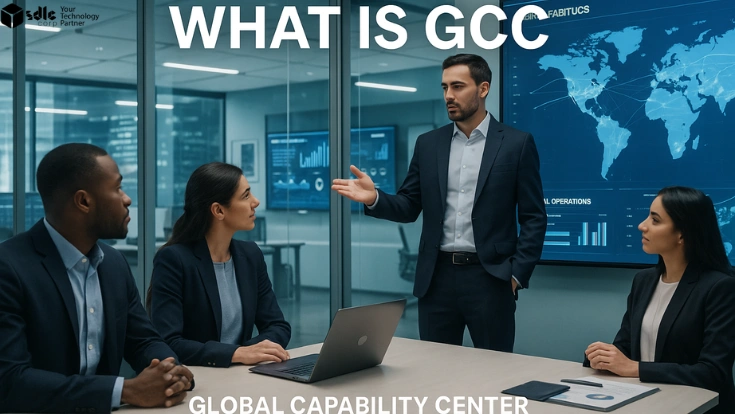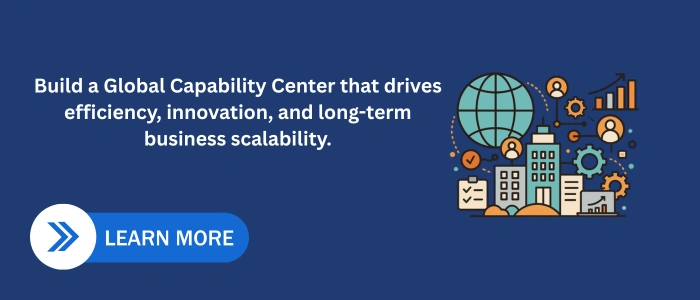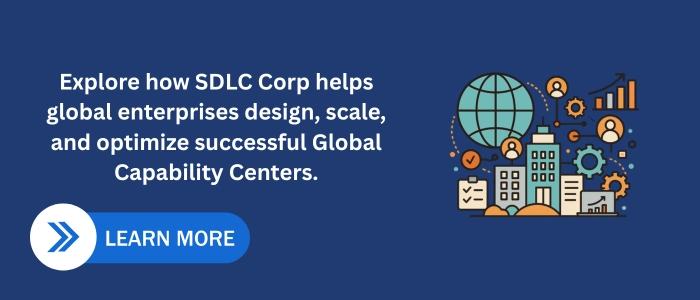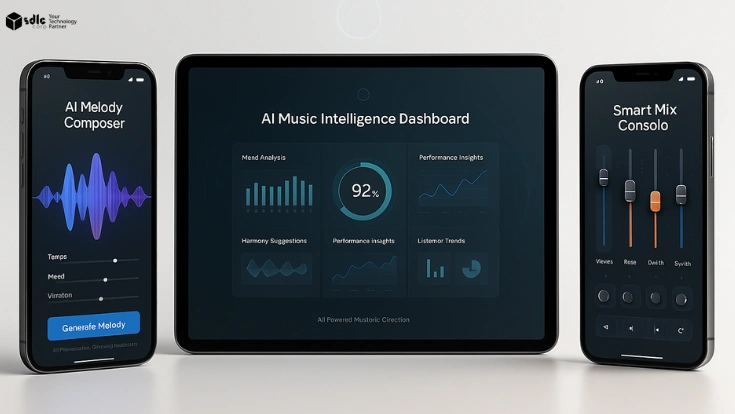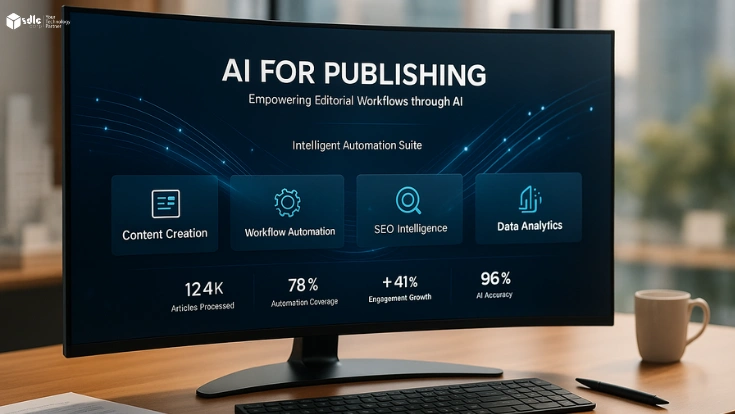Introduction
A Global Capability Center (GCC) is a business unit established by multinational companies to manage key functions, including IT, finance, analytics, and R&D. Unlike outsourcing, GCCs provide organizations with full control, ensuring compliance, quality, and alignment with global objectives. They help businesses cut costs, improve efficiency, and drive innovation across regions.
This blog explains the role of Enterprise Capability Centers, outlines a strong GCC Transformation Strategy, and highlights the main advantages of Capability Centers compared to outsourcing models that focus only on short-term results.
Understanding the Concept
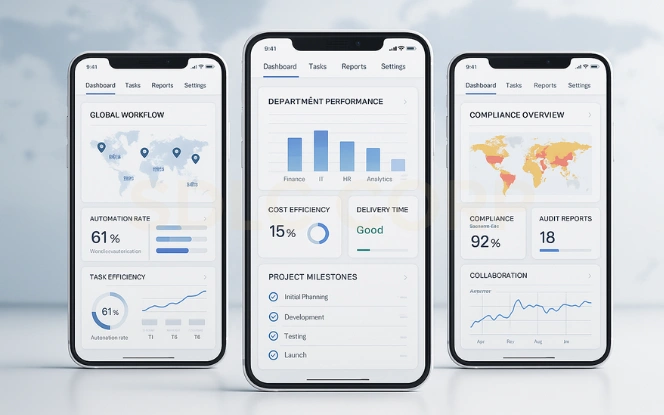
A Global Capability Center is more than a support arm-it’s a strategic engine that integrates people, processes, and technology under a unified framework. GCCs act as the bridge between global strategy and local execution. They provide operational control, protect intellectual property, and drive transformation across the enterprise ecosystem.
These centers function as Enterprise Capability Centers, responsible for designing and delivering innovation-led solutions. By consolidating global operations, organizations achieve visibility, governance, and scalability that traditional outsourcing models cannot match.
For instance, a GCC may oversee data analytics, software engineering, R&D, or business automation across multiple regions. Over time, these centers evolve from process hubs into innovation catalysts, using emerging technologies like AI, analytics, and automation to improve decision-making, speed, and performance.
GCCs also foster collaboration between headquarters and local markets. This ensures faster alignment on strategic initiatives and smoother execution across departments.
To explore how leading organizations establish efficient capability centers, visit Global Capability Centers by SDLC Corp.
Role of GCC in Business Operations
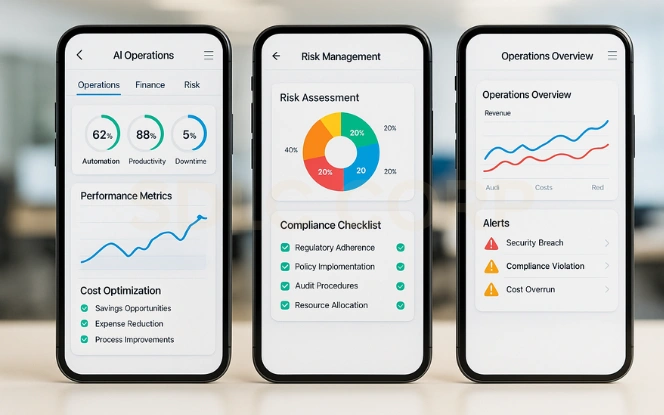
A Global Capability Center plays a vital role in managing and transforming enterprise operations. It ensures consistency, scalability, and innovation across all business functions by combining global oversight with local execution.
Key Roles of an Enterprise Capability Center:
- Operational Excellence: GCCs optimize workflows, eliminate redundancies, and standardize business processes to improve delivery speed and cost efficiency.
- Governance and Compliance: They implement a robust control framework, monitor performance using clear KPIs, and ensure regulatory adherence across geographies.
- Technology Enablement: By adopting automation, analytics, AI, and cloud systems, GCCs empower organizations to modernize their operations.
- Data-Driven Decision-Making: GCCs collect and analyze data to improve strategic forecasting and business planning.
- Talent Development: They attract, train, and retain skilled professionals in areas like digital transformation, engineering, and analytics.
The success of a GCC depends on its ability to integrate business priorities with technological capabilities. Over time, these centers evolve into strategic enablers, driving innovation and operational efficiency throughout the enterprise.
Learn how high-performing organizations achieve operational excellence through GCCs in Build a High-Performance Global Capability Center in the UAE.
Advantages of Capability Centers
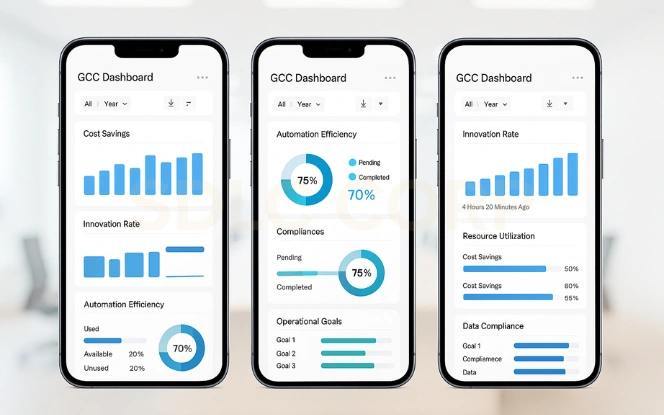
The advantages of Capability Centers go beyond cost savings; they drive long-term enterprise growth, innovation, and resilience.
- Strategic Ownership and Control
A GCC is 100% owned by the parent company, ensuring alignment with corporate objectives. This full control allows organizations to protect intellectual property and enforce consistent quality standards. - Operational Efficiency and Scalability
Through automation and standardized systems, GCCs reduce turnaround times and enhance collaboration between global teams. They make it possible to scale quickly while maintaining service excellence. - Access to Global Talent
Establishing GCCs in high-skill regions allows companies to leverage specialized talent in technology, analytics, and digital operations. These diverse skill sets strengthen innovation pipelines. - Accelerated Digital Transformation
By integrating automation, cloud computing, and AI-based analytics, GCCs act as transformation hubs. They drive enterprise-wide innovation and help businesses stay competitive in evolving markets. - Enhanced Compliance and Security
Centralized control ensures strict adherence to international laws, data privacy standards, and regulatory requirements. GCCs often achieve higher compliance scores than vendor-managed outsourcing models. - Long-Term ROI and Innovation Growth
While setup costs may be high initially, the long-term returns include higher efficiency, faster innovation cycles, and lower dependency on third parties. Mature GCCs can reduce operational expenses by up to 40%.
Learn more about scaling through innovation in AI-First Global Capability Centers for Scalable Growth in the UK.
Capability Center Operating Framework
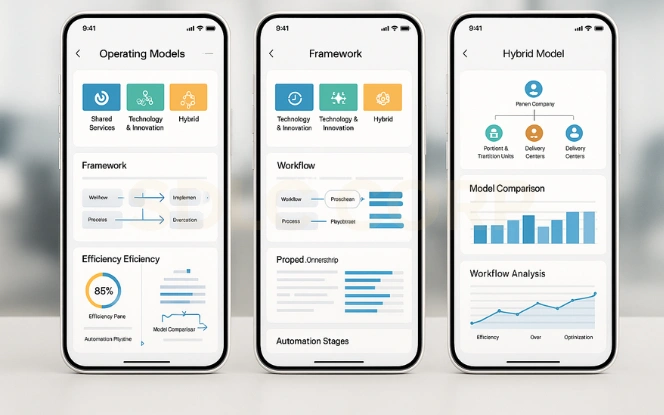
A Capability Center Operating Framework defines how the GCC functions, delivers results, and collaborates with headquarters. A strong framework focuses on agility, efficiency, and business alignment.
- Shared Services Model
Centralizes support functions like HR, finance, and procurement to improve efficiency and reduce costs. This model is best for organizations looking to streamline transactional operations. - Technology and Innovation Model
Focuses on research, product development, and software engineering. These GCCs act as innovation labs, driving automation, AI, and digital initiatives. - Hybrid Model
Combines both business support and innovation functions to balance cost efficiency with value creation. - Center of Excellence (CoE)
Dedicated to niche areas such as data science, AI, or cybersecurity. CoEs focus on creating intellectual capital, reusable frameworks, and scalable digital assets. - Governance and KPI Frameworks
The most successful GCCs monitor metrics like cost per transaction, automation rate, and innovation impact. These KPIs ensure every activity aligns with the global strategy.
A well-structured Capability Center Operating Framework helps transform the GCC into a performance-driven ecosystem that supports global scalability and business resilience.
Building a GCC Transformation Strategy
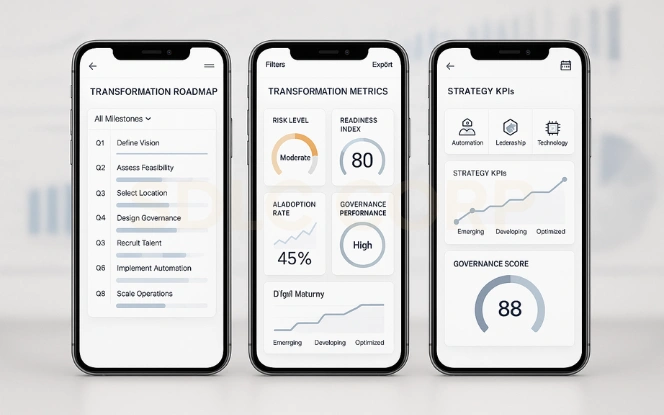
A GCC Transformation Strategy outlines how an organization plans, builds, and scales its capability center to achieve long-term success. It involves a blend of operational design, talent planning, and technology integration.
- Define Clear Objectives
Determine the GCC’s purpose: whether to reduce costs, innovate faster, or improve operational control. Objectives guide governance structures and hiring strategies. - Conduct Feasibility Analysis
Assess factors like local regulations, infrastructure, and talent availability. A detailed risk and opportunity assessment ensures smooth execution. - Select the Right Location
Choosing regions with strong digital infrastructure and skilled professionals is critical. The location should support collaboration and offer a favorable business climate. - Design Governance Models
Set up reporting hierarchies, define accountability, and align leadership at every level. Governance models should support autonomy while maintaining alignment with headquarters. - Build a Future-Ready Workforce
A GCC’s strength lies in its people. Continuous learning programs, leadership training, and exposure to emerging technologies help teams deliver high performance. - Integrate Technology and Automation
AI, data analytics, and cloud platforms must be embedded into daily operations. Automation helps scale business functions while improving consistency and transparency. - Scale and Optimize Gradually
Start with pilot functions to measure success, then expand based on data insights. A phased approach ensures sustainable growth and risk control.
Organizations that follow a well-structured GCC Transformation Strategy achieve faster time-to-market, cost efficiency, and long-term business resilience.
For more insights, see High-Performance GCC Solutions in the US.
Capability Center vs Outsourcing
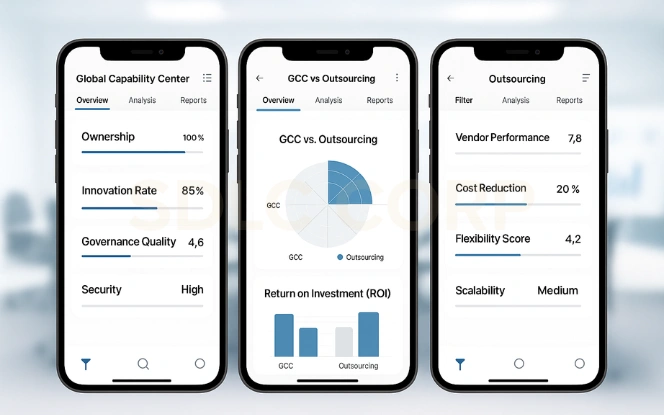
The Capability Center vs Outsourcing debate centers on ownership, innovation, and control. While outsourcing emphasizes flexibility, GCCs focus on sustainable business value.
| Aspect | Global Capability Center | Outsourcing |
|---|---|---|
| Ownership | 100% parent-owned | Vendor-managed |
| Control | Full internal governance | Limited oversight |
| Focus | Innovation and long-term growth | Short-term task execution |
| Security | High data protection | Shared responsibility |
| ROI | Compounding over time | Immediate but limited |
| Scalability | Structured and strategic | Vendor-dependent |
For example, a company may outsource non-core IT support but use its Enterprise Capability Center to handle critical functions like automation, analytics, and product engineering. This balance offers both flexibility and control.
GCCs provide consistent performance, operational transparency, and a long-term innovation mindset-advantages that outsourcing models often lack.
Challenges in Establishing a Global Capability Center
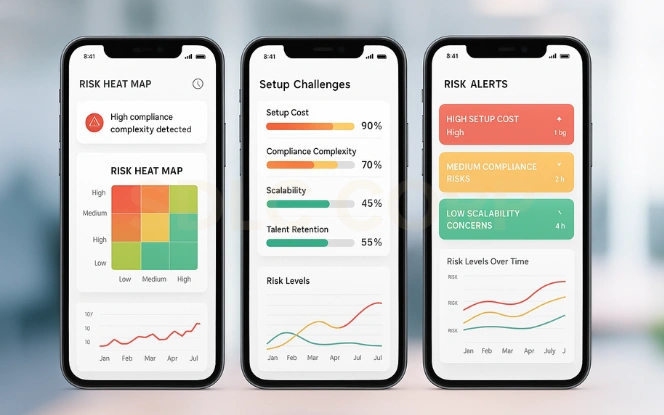
Building a Global Capability Center involves navigating challenges related to setup costs, talent, and scalability. Understanding these obstacles helps in effective planning.
- High Initial Investment
Setting up infrastructure, digital systems, and compliance frameworks requires significant capital. However, automation and shared services eventually balance costs. - Talent Acquisition and Retention
Attracting skilled professionals across multiple regions is challenging. Offering career development opportunities and flexible work arrangements can help maintain engagement. - Cultural and Operational Integration
Aligning global corporate values with local cultures requires clear communication and leadership involvement. Unified performance management systems can strengthen collaboration. - Regulatory and Legal Complexity
Every market has unique tax laws, labor codes, and data regulations. Partnering with local legal experts helps ensure compliance from the start. - Scaling Sustainably
Rapid expansion may strain resources and governance. Phased scaling, guided by real-time performance metrics, ensures sustainable growth.Enterprises that anticipate and mitigate these challenges early often achieve operational stability within 18–24 months of GCC establishment.
Best Practices for Enterprise Capability Centers
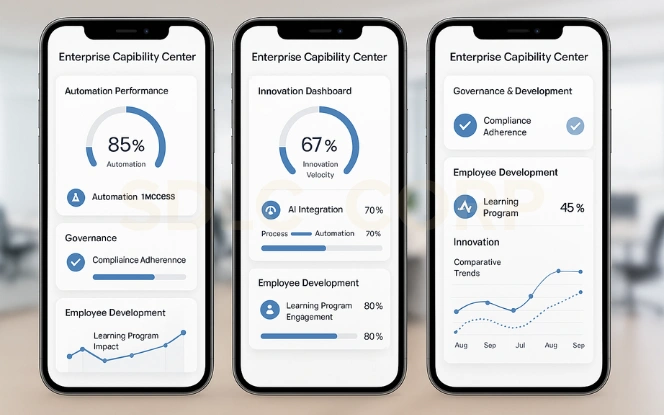
To build a world-class Enterprise Capability Center, organizations must combine operational excellence with innovation and governance.
- Start with a Clear Vision: Define long-term business goals and align them with the GCC’s purpose.
- Involve Leadership: Active engagement from top executives ensures accountability and alignment.
- Adopt a Digital-First Mindset: Integrate cloud, AI, and analytics tools to drive efficiency and agility.
- Prioritize Cybersecurity: Protect data assets with global standards such as ISO 27001 or SOC 2.
- Encourage Continuous Learning: Establish training programs to build leadership and technical expertise.
- Measure What Matters: Monitor KPIs such as process accuracy, automation adoption, and innovation impact.
- Foster Innovation Culture: Encourage teams to experiment with new ideas and recognize value-driven results.
A well-managed GCC evolves into a strategic unit that accelerates growth, supports transformation, and enhances the organization’s competitive advantage.
Future Outlook for Global Capability Centers
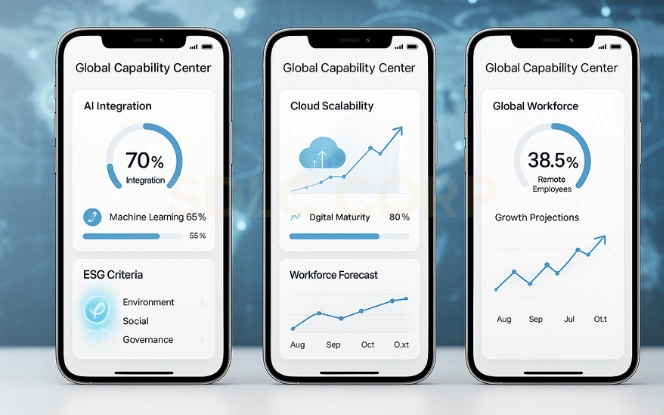
The future of Global Capability Centers lies in innovation, digital maturity, and strategic agility. These centers are set to become engines of transformation for global enterprises.
Emerging Trends:
- AI-Driven Decision-Making: GCCs will use advanced analytics and predictive models to optimize resource allocation.
- Sustainability and ESG Integration: Centers will focus on green technology adoption and ethical governance.
- Cloud and Hybrid Ecosystems: Multi-cloud operations will enhance flexibility and reduce downtime.
- From Cost Centers to Profit Centers: Mature GCCs will generate revenue through digital products and intellectual property creation.
- Global Collaboration Models: Cross-border teams using virtual platforms will redefine productivity and workforce diversity.
As technology advances, Global Capability Centers will stand at the forefront of innovation, shaping the way global businesses operate and evolve.
Conclusion
A global capability center is more than a cost-efficient structure. It is a long-term strategic investment that drives innovation, governance, and scalability. Therefore, it supports GCC in business operations, strengthens GCC’s setup strategy, and ensures sustainable benefits of a GCC.
Ultimately, choosing the right GCC operating model and evaluating GCC vs outsourcing helps organizations achieve operational excellence.
For expert guidance, contact SDLC Corp today to enhance your GCC with AI and automation.
FAQs
What Is A Global Capability Center (GCC)?
A Global Capability Center (GCC) is a fully owned offshore unit established by multinational companies to manage core functions like IT, finance, analytics, and R&D. Unlike outsourcing, GCCs give organizations direct control over processes, governance, and data while improving efficiency and innovation.
What Are The Key Benefits Of A GCC For Businesses?
The benefits of a GCC include operational efficiency, strategic alignment, cost savings, and access to global talent. Moreover, they strengthen compliance, improve innovation through automation, and help organizations expand globally while maintaining centralized control.
How Does The GCC Operating Model Work?
A GCC operating model defines how teams, technologies, and governance structures collaborate to deliver value. Typically, models include Shared Services, Technology and Innovation Centers, Hybrid GCCs, and Centers of Excellence (CoE). Each, in turn, supports scalability and aligns with overall business strategy.
How To Build An Effective GCC Setup Strategy?
A strong GCC setup strategy begins with defining business goals, selecting the right location, building governance frameworks, hiring skilled talent, and implementing secure technology systems. Furthermore, successful GCCs follow a phased rollout and evolve continuously based on performance data.
What Is The Difference Between GCC And Outsourcing?
When comparing GCC vs outsourcing, the main difference lies in ownership and control. In general, a GCC is owned and managed by the parent company, ensuring strategic alignment and data security. Conversely, outsourcing involves external vendors, offering flexibility but less control over governance.

